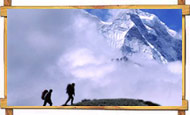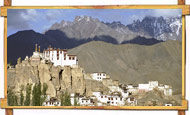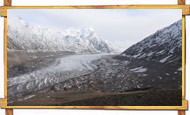|
Home >>
Places to Visit Around Himachal >>
Ladakh
|
Ladakh |
Facts & Figures of Ladakh
Location -
Northern Most Part Of J&K.
Altitude -
9,000m.
Best Time -
May To September
Ladakh is a land like no other. Bounded by two of the world's mightiest
|

|
mountain ranges, the Great Himalayas and the Karakoram, it lies athwart two other, the Ladakh range and the Zanskar range. In geological terms, this is a young land, formed only a few million years ago by the buckling and folding of the earth's crust as the Indian sub-continent pushed with irresistible force against the immovable mass of Asia. Its basic contours, uplifted by these unimaginable tectonic movements, have been modified over the millennia by the opposite process of erosion, sculpted into the form one sees today by wind and water.
Prime Attractions of Ladakh :
Zanskar
About 20-km south of Rangdum stands the Pazila watershed across which lies Zanskar, the most isolated of all the trans Himalayan Valleys. The Panzela Top (4,401 m) is the picturesque tableland adorned with two small alpine lakes and surrounded by snow-covered peaks. more..
Hemis
Thanks to the Hemis Setchu festival - one of the few held in summer, when the passes are open - Hemis, 45-km southeast of Leh, is the most famous Gompa in Ladakh.
Sankar Gompa
Sankar Gompa, 3-km north of the town centre, is among the most accessible monasteries in central Ladakh - hence its restricted visiting hours for tourists
Baralacha Pass
On the long Manali -Leh road and providing a route across the Baralacha range is the famous Baralacha Pass. It is situated at a spectacular 16,400 ft above sea level. The pass itself is 8-km long, and is literally the pass "where many roads meet".
Dah-Hanu
Dah and Hanu are places on the far side of the great Indus River on the far side of Leh. Surrounded by the great Hindu - Kush mountains and peopled by a hardy but gentle people who have a bank of strange legends to relate for the weary traveller's ears.
Dosmoche
An ancient tradition started by the kings of Ladakh, Docmoche is still celebrated every year in February with great pomp and fervour. The courtyard of the chapel below the gates of the Leh of the Leh Palace comes alive with the music of drums and the thumping steps of the masked Lamas from different monasteries performing the sacred dance-drama.
Hemis High Altitude Wildlife Sanctuary
The Hemis High Altitude National Park includes the catchments of two valleys, which drain into the River Indus. It is named after the famous monastery -- Hemis, and sprawls over 600-sq-km in the Markha And Rumbak valleys.
Lakes in Ladakh
The Tso Morari Lake is one of the largest lakes in Ladakh region and is almost like an inland sea. At an altitude of almost 4,500 meters, the Pangong Tso is only 8-km wide at its broadest but is an amazing 134-km long. Kyaghr lake is the halting place for trekkers moving from the Kiangdum camping ground to the Tsomorari Lake.
|
|

|
Lamayuru
If one sight could be said to sum up Ladakh, it would have to be Lamayuru Gompa, 130-km west of Leh. Hemmed in by a moonscape of scree covered mountains, the white washed medieval monastery towers above a scruffy cluster of tumbledown mud brick houses from the top of a near vertical, weirdly eroded cliff. |
|
Likkir
6-km to the north of the main Leh-Srinagar highway, shortly before the village of Saspol, the large and wealthy Gompa of Likkir, home to around one hundred monks, is renowned for its huge yellow statue of the Buddha to come which towers above the terraced fields and village below.
Losar
Losar is the most elaborate of all the socio -religious events of Ladakh. It involves the entire population of the region. Interestingly, the rites and rituals are a mixture of Buddhist and the pre Buddhist Bon religious practices.
Monastic Festivals
The monastic festivals are the events that provide the average Ladakhi with the spice of life. No other festival can match them in religious and entertainment value. These festivals are held to commemorate the founding of a monastery, the birthday of its patron saint or major events in the evolution of Tibetan Buddhism.
Nubra Glacier
The Nubra glacier is located on the southern slopes of the Karakoram Range in the Ladakh region of Jammu and Kashmir. It is a large glacier located in a huge amphitheater that is ringed by towering peaks.
Padum
Once the capital of the ancient kingdom of Zanskar, Padum (3,505 m) is the present day administrative headquarters of the region. With a population of nearly 1,500, Padum can be described as the most populous settlement of Zanskar, otherwise a very scarcely inhabited valley.
River Rafting
While water levels are high, between the end of June and late August, Leh's more entrepreneurial travel agents operate rafting trips on the river Indus
Sankoo
A picturesque expanse surrounded by colorful rocky mountains, Sankoo is an upcoming township with a small bazaar and numerous villages around. Dense plantations of Poplers, Willows, Myricarea and wild Roses fill the bowl shaped valley, giving it the ambience of a man-made forest tucked within the mountain ramparts. |
Siachen Glacier
The Siachen glacier lies in the extreme north-central part of Jammu and Kashmir near the border of India and Tibet. With a length of about 72-km, Siachen is known as the largest glacier in the world outside the Polar Regions.
|
 |
Sind Valley
Considered by many to be the most beautiful of Kashmir's side valleys, the Sind is also the access route to the Zoji la pass.
Stongdey/ Stongde Monastery
The monastery of Stongdey lies 18-km to the north of Padum, on the road leading to Zangla. An old foundation associated with the Tibetan Yogi, Marpa, Stongdey is now the second largest monastic establishment of Zanskar
The Nubra Valley
The 18,640 feet high Khardung La pass forms the divide between the Nubra Valley and Leh. After crossing the Khardung La, one descends to a place called "Khalsar", situated on the left bank of the Shyok River.
Chong Kumdan Glacier
The Chong Kumdan glacier is situated on the lower slopes of the Karakoram Range. It is located in a trough that is surrounded by high peaks on all sides. The melt-water from this glacier flows into the Shyok River, which in turn joins the Indus River. The Chong Kumdan glacier had blocked the flow of the Shyok River several times in the past. Thus the Gapshan Lake was formed which drained away once the ice dam gave way. This glacier can be approached via Skardu in Ladakh.
Gasherbrum Glacier
The Gasherbrum glacier is located on the southern slopes of the Karakoram Range in the Baltistan area of Ladakh. It lies at the base of the Gasherbrum peak and has a length of about 26-km. The melt-water from this glacier joins the Shyok river system. Glaciers in hanging valleys open into the main glacier. No vegetation grows in this tract due to the extreme conditions of cold. This glacier can be approached via Skardu in Ladakh.
Rakaposhi Glacier
Rakaposhi glacier is located on the lower slopes of the Karakoram Range in the Gilgit area of Ladakh. It is tenanted on the north-facing slopes of the Rakaposhi massif. The Rakaposhi glacier feeds an eastern tributary of the Hunza River, which in turn flows into the Indus River. The Rakaposhi glacier lies in a trough whose bottom gently slopes towards the north and northwest. Boulders and rocks are strewn all over the surface. This glacier can be approached via Gilgit in the Ladakh region of Jammu and Kashmir.
Shyok Valley & Indus Valley
Indus is a large valley formed by the main channel of the Indus River as it flows across Ladakh. The Shyok Valley is the valley of the Shyok River -- the river of death. This is a "Yarkandi" (Central Asian) name, probably given by the Central Asian traders
Thak Thok Gompa
Clustered around a lumpy outcrop of eroded rocks, 4-km up the valley from Chemrey, the small Gompa of Thak Thok (pronounced Tak Tak and meaning "top of the rocks") is the sole representative in Ladakh of the ancient Nyingmapa order.
How To Get There - Ladakh :
Moving On
As befits India's remotest Himalayan town, Leh is singularly hard to get to, and even harder to leave. Fragile road and air links mean visitors all too often find themselves stranded waiting for passes to open or planes to appear. Wherever and however one travels, book an onward ticket as far in advance as possible and be prepared for delays if the weather changes.
Local Transport
The best and most reasonable way to travel within the region way to travel within the region is by public buses, which ply on fixed routes according to fixed time schedules. The most comfortable and convenient through expensive mode of travel, however, is by taxis, cars, and Gypsy, which are available for hire on fixed point-to-Point tariff.
For visits to the newly opened areas of Nubra, Changthang and Dah-Hanu it is mandatory to engage the services of a registered/recognized travel agency for making all the requisite arrangements including internal transport. Detailed information about bus schedules, taxi tariff, travel agencies, etc. can be obtained from the Tourist Office.
By Road
The main overland approach to Ladakh is from the Kashmir Valley via the 434-km Srinagar-Leh road, which remains open for traffic from early June to November. The most dramatic part of this road journey is the ascent up the 11,500 feet/3,505 m high Zoji-la, the passing the Great Himalayan Wall that serves as the gateway to Ladakh.
The J&K State Road Transport Corporation (J&KSRTC) operates regular Deluxe and Ordinary bus services between Srinagar and Leh on this route with an overnight halt at Kargil. Taxis, cars and jeeps are also available at Srinagar for the journey. Groups can charter deluxe and A-class buses for Leh, Kargil or Padum (Zanskar) from the J and K SRTC at Srinagar.
Since 1989, the 473-km Manali-Leh road has been serving as the second land approach to Ladakh. Open for the traffic from around mid-June to early October, this high road traverses the upland desert plateaux of Rupshu whose altitude ranges from 3,660m to 4,570m.
A number of high passes fall en route among which the highest one, known as Taglang-la, is the world's second highest motor able pass at an altitude of 17,469 feet/5,325m. H.P. Tourism, H.P. SRTC and J&K SRTC operate Deluxe and Ordinary bus services between Manali and LEH. The bus journey between Leh and Manali takes about 19 hours or two days with an overnight halt in camps at Serchu or Pang. Gypsy and jeep taxis are also available, both at Manali and Leh.
By Air
The quickest way out of Ladakh region is by plane. Airline service operates regular scheduled flights to Leh from Delhi, Chandigarh, Jammu and Srinagar. Some private airlines are also planning to operate air services betwe4n Delhi and Leh in the near future.
Places To Stay - Ladakh
Leh offers a variety of accommodation to suit almost every pocket or preference. Most hotels are family-run establishments. Hotels are classified into A, B, C and Economy categories while Guest Houses fall under Upper, Medium and Economy class. Tariff quoted in the meals, a system followed by most establishments. Tariff quoted in the A and B category hotels includes all meals, a system followed by most establishments.
The Guest House is a less formal facility offering rooms in a part of a residential house or its annex, where the guests can share the family kitchen for meals. As a part from the low tariff offered for accommodation ranging from very good to merely basic, the Guest House system also provides an opportunity for the tourists to see and experience Ladakhi life from the inside.
In the newly opened areas of the region- Nubra, Changthang and Dah-Hanu- tourist infrastructure is also been adequately developed. The State Tourism Department has developed accommodation facilities like Tourist complexes and Hikers Huts at Tangse and Spangmik on the Pangong lake circuit, Korzok on the Tso-moriri Lake, Deskit and Panamic in the Nubra Valley, and at Biama in the Drokpa area.
Climate - Ladakh :
Weather of The Cold Desert
Ladakh lies at altitudes ranging from about 9,000 feet (2,750m) at Kargil to 25,170 feet (7,672m) at Saser Kangri in the Karakoram. Thus summer temperatures rarely exceed about 270 C in the shade, while in winter they may plummet to -200 C even in Leh. Surprisingly, though, the thin air makes the heat of the sun even more intense than at lower altitudes; it is said that only in Ladakh can a man sitting in the sun with his feet in the shade suffer from sunstroke and frostbite at the same time!
General Information - Ladakh :
Clothing
Zanskar experiences drastic fluctuations in the daily temperature even during the height of summer. While the days are pretty warm, even hot at times due to the desertic effect, the evenings can become quite chilly thus requiring additional clothing. It is advisable to be prepared for this situation with a pullover and a down jacket. Other essential items include a sturdy pair of walking shoes, a good sleeping bag, and a pair of woolen socks or some thick cotton socks. It is also essential to bring a quality tent if the intention is to travel or trek around on your own, and a good quality rucksack for back packing. It is also important to carry your provisions from Srinagar or Kargil, if a longer tour of the adjoining villages is intended.
|
| |
|